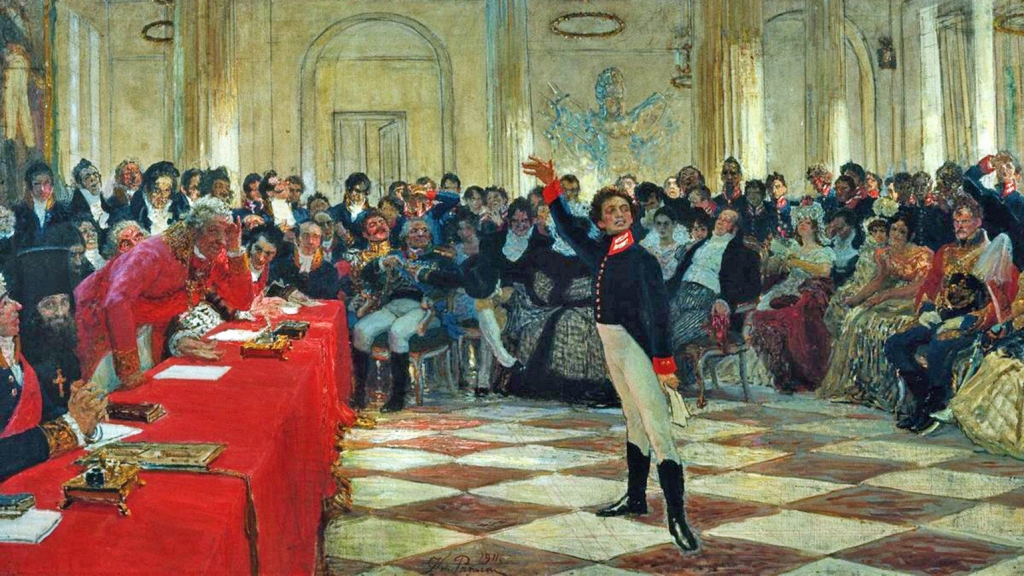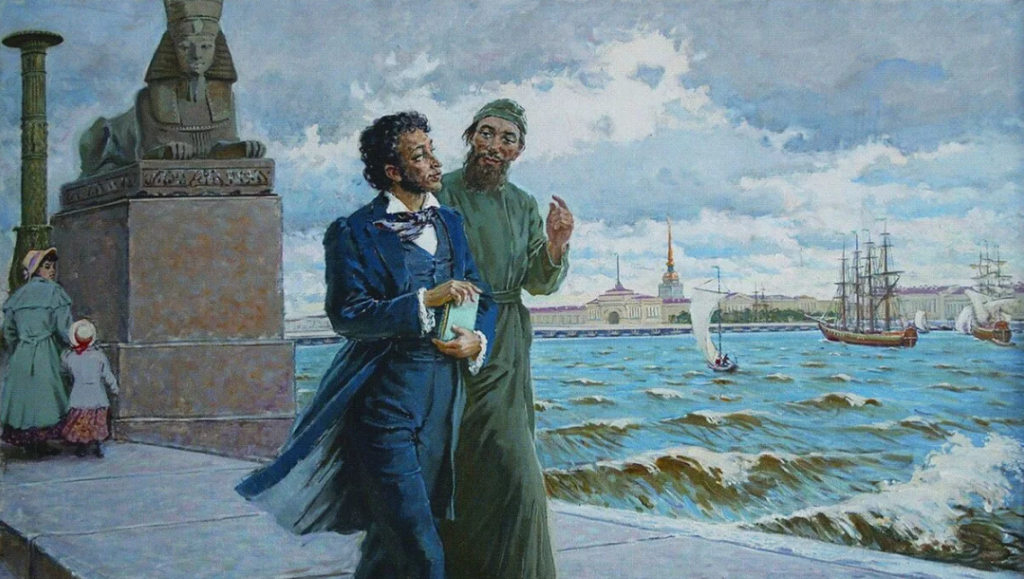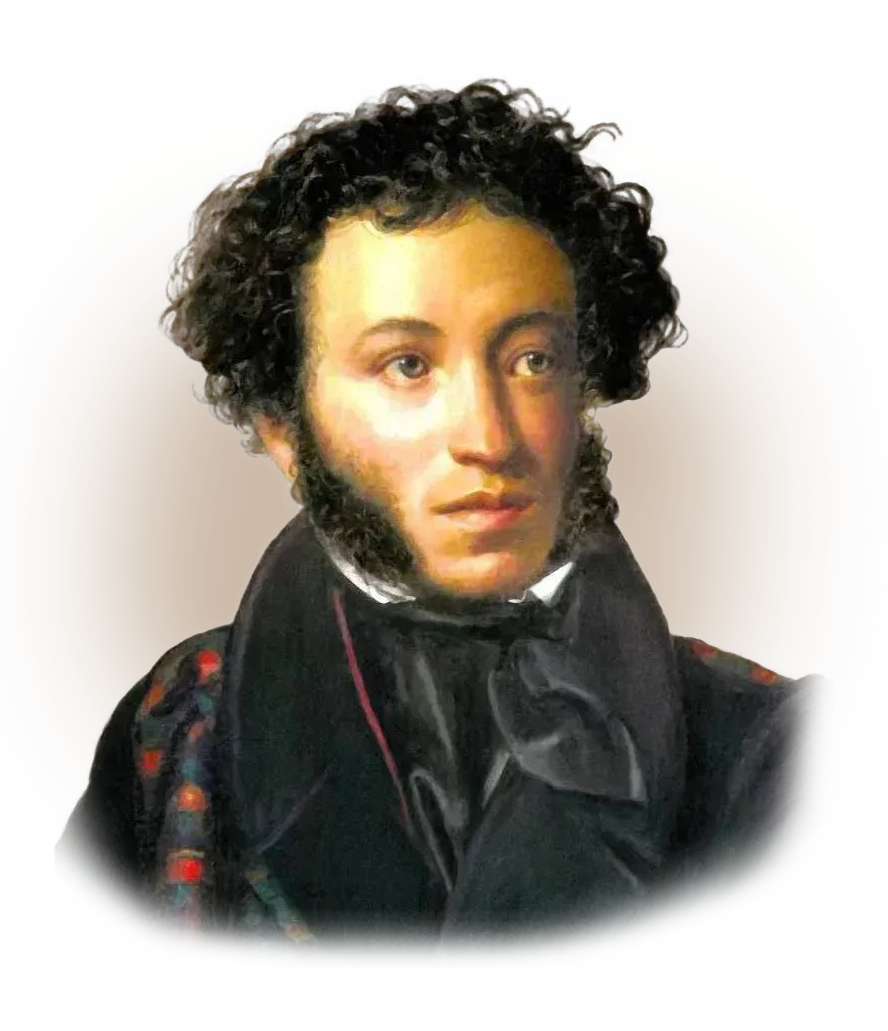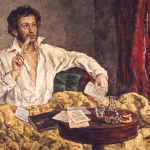
06.01.2023
The first period of Pushkin’s work (1813 – summer 1817) falls during a fierce struggle between the Karamzin and Shishkovists. Pushkin, a lyceum student, actively joined it on the side of Karamzin.
1. 1813— May 1817 — lyceum period
The epigrams against the “talkers”, numerous polemical antics in the poetry of these years, his acceptance into “Arzamas” (with the nickname “Cricket”) testify to the fighting position within this literary direction, the orientation to the poetic tradition of Zhukovsky and Batyushkov. However, a number of signs of the literary position of the young Pushkin are not only incompatible with the poetics of the Karamzinists, but also deeply contradict it. Already in his lyceum years, he was close to writers who fought against the deadened canons of classicism, sought to modernize the literary language, to bring Russian literature closer to European literature.
If we do not even talk about the interest in philosophical prose in the spirit of the XVIII century (the idea of the novel “Fatama”), Pushkin’s work of these years clearly shows an interest in epic genres and especially in a satirical poem, which completely fell out of the poetics of the Karamzinists. “The Monk” (1813), “Bova” (1814), “The Shadow of Barkov” and “The Shadow of Fonvizin” (1815) convincingly testify to the artistic orientation associated with the satirical tradition of the XVIII century. In the lyrics, one can note the influence of Derzhavin (“Memories in Tsarskoye Selo”), D. Davydov (“Feasting Students”, “Riders”, etc.), Milonov, etc. “civil” poets of the 1810s (“To Licinius”). The circle of Western European influences – from Voltaire to Ossian.

The lack of unity in Pushkin’s lyceum work is sometimes interpreted as the result of the creative immaturity of the poet who has not yet found his way. However, very soon, being involved in various artistic traditions and intonations, the poet reached the perfection of mature masters in each of them. If in elegies and romances (for example, “Desire” or “Singer”) Pushkin acts as a mature rival of such a master already recognized at that time as Zhukovsky, then in a friendly message (“Gorodok”) he is equal to Batyushkov. In “Memoirs in Tsarskoye Selo”, undoubtedly the central work of the Lyceum period, Pushkin, synthesizing the artistic experience of Batyushkov’s historical elegies with Derzhavin’s ode, was able to achieve a completely unexpected ideological and artistic sound, giving civic-patriotic poetry an excitedly lyrical pathos and personal intonations.In 1814, the journal “Bulletin of Europe” publishes Pushkin’s first poem, “To a friend of the poet” (signed: Alexander N.K.sh.p.). In January 1815, the young poet reads his poem “Memories in Tsarskoye Selo” in the presence of Derzhavin. In April, it was published in the magazine “Russian Museum” and for the first time signed with the full name: Alexander Pushkin.
2. June 1817— early May 1820 — Petersburg period
The second period of creativity falls for a time from the autumn of 1817 to the spring of 1820 . Released from the Lyceum, Pushkin settled in St. Petersburg. This period is marked by a rapprochement with the Decembrists. The poet constantly meets with F. Glinka, N. Turgenev, Chaadaev and is strongly influenced by their ideas. Pushkin joins the literary societies “Green Lamp” and “Free Society of Lovers of Russian Literature”, which are closely connected with the Decembrist movement. His political lyrics become an expression of the ideas of the “Union of Prosperity”. Under the direct influence of Turgenev, program poems are created: the ode “Liberty” and “Village”. Having tried to solve the problem of creating relevant political lyrics based on the tradition of the XVIII century in the ode “Liberty”, Pushkin later did not turn to this experience anymore, and Kuchelbecker’s call in 1824 to revive the ode caused him an ironic attitude. Interesting are the attempts to use “small” genres, traditionally considered marginal, and on their basis to create civic poetry that combines high pathos with intimate intonations. Such experiments are done with a madrigal (“Plyuskovoy”, “An inexperienced amateur from the edges of others”), a friendly message (“lampist” cycle).
The message “To Chaadaev” is particularly interesting in this regard. The first lines of the poem should activate in the minds of readers the images and stylistics of a dull elegy. It is only from the sixth verse that it is revealed that we are talking about the thirst for freedom and struggle. The third stanza merges the imagery of political and love lyrics into a tense-emotional unity. And only after that there are two final stanzas, in which the passionate impulse gives way to a sublime dream, and the intense love phraseology is replaced by the image of military comradeship.

In the poem “An inexperienced lover of the Edges of strangers” Pushkin placed side by side as two comparable high ideals of a citizen “With a noble soul,/ Loftily and ardently free” and a woman “not with cold beauty, / But with a fiery, captivating, lively”. In the eyes of the poet, love does not contradict freedom. Pushkin’s vivid political temperament manifested itself in an evil satire on Alexander the First (“Fairy Tales. Noel”). This period is characterized by the interaction of three stylistic elements – archaic, romantic and everyday.
The main creation of this period was the poem “Ruslan and Lyudmila”. Work on it ended only in the spring-summer of 1820. Karamzin condescendingly called it a “poem”, and Dmitriev spoke of it as indecent. A member of the “Union of Prosperity” N. I. Kutuzov condemned the poem for the lack of “sublime feelings”. Criticism failed to understand the main artistic principle of the poem – the contrasting juxtaposition of incompatible genre-stylistic passages, which resulted in irony directed at the very principle of genre. Critics could not determine the author’s point of view, but they saw that irony replaces morality.
3. May 1820— July 1824 — the period of southern exile
The third period of creativity is associated with Pushkin’s stay in southern exile (1820-1824). Creativity of these years was under the sign of romanticism. In the “southern” period, the poems “The Caucasian Prisoner” (1821), “Gavriliada” (1821), “The Robber Brothers” (1821-1822), “The Fountain of Bakhchisarai” (821-1823) were written, “Gypsies” (completed in 1824 in Mikhailovsky) were started, “Vadim” was conceived and partially started (1822), “Actaeon”, “Bova”, “Mstislav” (all sketches 1821-1822). The “Caucasian Prisoner” brought fame, the “Bakhchisarai Fountain” strengthened Pushkin’s position as the head of Russian romantics. In 1824, in the “Son of the Fatherland” M. Karniolin-Pinsky, in his review of the Fountain of Bakhchisarai, spoke about “byronism”. V. M. Zhirmunsky: “The new literary genre of the “romantic poem”, created by Pushkin on the model of Byron’s “oriental poems”, depicts reality in the refraction of the subjective lyrical perception of the hero with whom the poet identifies himself emotionally.” G. A. Gukovsky about the poem “The Caucasian Prisoner”: “The Byronic characterology of individuality struggles in it with breakthroughs into the objective.”
The structure of the romantic poem was created by transferring the features of elegy into the epic genre. It is not by chance that Pushkin, in a letter to Gorchakov, defined the genre of The Prisoner as a “romantic poem”. However, another descriptive element is actively present in the “southern” poems, which was not conceived in the spirit of Delil’s “Gardens” in Voeykov’s translation. It should be a description of the life of the people, an exotic ethnic group and folk characters full of wild strength and energy. “The Robber Brothers”, “The Black Shawl”, and “The Song of the Prophetic Oleg” were associated with this trend – usually romantics were interested in the fact that Oleg is a great warrior; for Pushkin, the theme of rock, man and power is interesting. Oleg is a toy against the background of fate. He thinks he can change everything, but he doesn’t know his fate to the end. Neither can the tsar appoint a poet. A poet needs inner freedom, and poems commissioned by the tsar will not become valuable. Pushkin’s further development was influenced by his connection with the Chisinau group of journalists. It is in Chisinau that the intensity of his political lyrics reaches the highest tension (“Dagger”, “Davydov”, etc.). In Pushkin’s mind, the possibility of an ironic attitude towards a disappointed hero or an assessment of this character through the eyes of the people loomed. The first possibility was connected with the idea of a comedy about a player and the initial (satirical) idea of the 1st chapter of “Eugene Onegin”, with the second – “Gypsies”. The tragic reflections of this period were expressed in the elegy “Demon”, the poem “The Desert Sower of Freedom” and the poem “Gypsies”. In these works, on the one hand, the tragedy of a non–popular romantic rebellion was at the center, and on the other – the blindness and submission of “peaceful peoples”. The main result of creative searches in 1822-1823 was the beginning of work on the novel in verse “Eugene Onegin”. The work lasted more than seven years.
4. August 1824— September 1826 — the period of exile in Mikhailovskoye
The young poet visited here for the first time in the summer of 1817 and, as he himself wrote in one of his autobiographies, was fascinated by “rural life, Russian bathhouse, strawberries, etc., — but I didn’t like it for long.” In 1824, Pushkin’s letter was opened by the police in Moscow, where he wrote about his passion for “atheistic teachings.” This was the reason for the poet’s resignation from the service on July 8, 1824. He was exiled to his mother’s estate, and spent two years there (until September 1826) — this is the longest stay of Pushkin in Mikhailovsky.
Shortly after Pushkin’s arrival in Mikhailovskoye, he had a major quarrel with his father, who actually agreed to the tacit supervision of his own son. At the end of autumn, all Pushkin’s relatives left Mikhailovsky.
Contrary to the fears of friends, solitude in the village did not become disastrous for Pushkin. Despite the difficult experiences, the first Mikhailovsky autumn was fruitful for the poet, he read a lot, reflected, worked. Pushkin often visited his neighbor on the estate P. A. Osipova in Trigorsky and used her library (Osipova’s father, a mason, an associate of N. I. Novikov, left a large collection of books). From Mikhailovskaya exile to the end of his life, he was bound by friendly relations with Osipova and members of her extended family. In Trigorsky in 1826, Pushkin met with Yazykov, whose poems had been known to him since 1824.

Pushkin completes the poems begun in Odessa, “The Conversation of a bookseller with a poet”, where he formulates his professional credo, “To the Sea” — a lyrical reflection on the fate of a man of the era of Napoleon and Byron, about the cruel power of historical circumstances over a person, the poem “Gypsies” (1827), continues to write a novel in verse. In the autumn of 1824, he resumed work on autobiographical notes, left at the very beginning in the Chisinau time, and pondered the plot of the folk drama “Boris Godunov” (completed on November 7 (19), 1825, published in 1831), wrote a comic poem “Count Nulin”. In total, the poet created about a hundred works in Mikhailovsky.
In 1825, he met Anna Kern, Osipova’s niece, in Trigorsky, to whom, as is commonly believed, he dedicated the poem “I remember a wonderful moment…”.
A month after the end of the exile, he returned “free to the abandoned prison” and spent about a month in Mikhailovsky. In the following years, the poet periodically came here to take a break from city life and write in freedom. In Mikhailovsky in 1827, Pushkin began the novel “The Blackamoor of Peter the Great”.
In Mikhailovsky, the poet also joined the game of billiards, although he did not become an outstanding player, however, according to the memories of friends, he wielded a cue on a cloth quite professionally
5. September — November 1830 — Boldin autumn
Boldinskaya autumn of 1830 is the most productive creative time in the life of A. S. Pushkin. The seclusion in the Bolshoe Boldino estate due to the declared cholera quarantine coincided with the preparation for the long-awaited marriage to Natalia Goncharova.
During this time, work on “Eugene Onegin”, the cycles “Belkin’s Stories” and “Little Tragedies” was completed, the poem “The House in Kolomna” and about 30 lyrical poems were written.
Spring and summer of 1830
On May 6, 1830, the engagement of Pushkin and Goncharova was officially announced. But the wedding was constantly postponed — Natalia Goncharova’s mother did not want to give her daughter without a dowry, but the ruined family had no money. In August of the same year, Pushkin’s uncle, Vasily Lvovich, died. The wedding was postponed again due to mourning, and Pushkin left Moscow on August 31 for Boldino to take possession of the nearby village of Kistenevo, allocated to him on the occasion of his marriage by his father. Before leaving, Pushkin quarreled with his future mother-in-law and in a letter written under the influence of an explanation with her, announced that Natalia Nikolaevna was “completely free”, he would only marry her or never marry.
Autumn
Pushkin arrived in Boldino on September 3, hoping to manage his affairs in a month. At first, he was afraid that the best working time (usually in the fall he wrote a lot) should be filled with the hassle of taking possession and mortgaging Kistenev. On this trip Pushkin took with him only three books: the second volume of the History of the Russian People by Polevoy, The Iliad translated by Gnedich and the works of English poets, including Barry Cornwall.
Pushkin’s plans were disrupted by the cholera epidemic that swept through Russia — because of quarantine, he stayed in Boldino for three months, which became one of the most fruitful periods in his work.
A reflection of his worries were the “Demons” and “Elegy” that appeared shortly after his arrival (“The fun that died out during the Crazy years…”). Soon, however, the bride’s letter restored his lost mental balance. Pushkin informed his friend and publisher Pletnev that in her “pretty letter” she “promises to marry me without a dowry” and invites him to Moscow. The affairs of Kistenev were entrusted to the clerk Peter Kireev, and the poet, confident that the Goncharovs had left choleric Moscow, had already informed a friend that he would appear there no earlier than a month later.
The autumn of 1830 was the time for Pushkin to sum up. Already in his letter to his parents with the notice of the engagement (April 6-11, 1830), he wrote that a new period was beginning; he told Pletnev the same from Boldin: “Hitherto he is me — and here he will be us. A joke!” (XIV, 113, September 29, 1830). The changes in his personal life coincided with the beginning of a new stage of literary activity. The poet opens the final chapter of “Eugene Onegin” with a retrospective picture of his work, symbolically presenting its development through the “change of the faces of the Muse”, and the direction of his literary evolution, according to Blagoi, as “movement through romanticism to realism, from “poetry” to “prose””.
6. Petersburg 1833-1835
In November 1833, Pushkin returned to St. Petersburg, feeling the need to change his life abruptly and, above all, to get out of the custody of the court.
On the eve of 1834, Nicholas I conferred on his historiographer the junior court title of Chamberlain. According to Pushkin’s friends, he was furious: this title was usually given to young people. In his diary on January 1 , 1834 , Pushkin wrote:
The day before yesterday I was granted the rank of Chamber junkers (which is rather indecent for my years). But the Court wanted N. N. [Natalia Nikolaevna] to dance in Anichkov.
At the same time, the publication of the “Bronze Horseman” was banned. At the beginning of 1834, Pushkin completed another, prosaic Petersburg story — “The Queen of Spades” and placed it in the magazine “Library for Reading”, which paid Pushkin immediately and at the highest rates. It was started in Boldin and was then intended, apparently, for the joint almanac “Troichatka” with V. F. Odoevsky and N. V. Gogol.

On June 25, 1834, Pushkin resigned with a request to retain the right to work in the archives necessary for the performance of the “History of Peter”. The motive was family affairs and the impossibility of a permanent presence in the capital. The petition was accepted with a refusal to use the archives, thus, Pushkin was deprived of the opportunity to continue working. Following Zhukovsky’s advice, Pushkin withdrew the petition. Later, Pushkin asked for a vacation for 3-4 years: in the summer of 1835, he wrote to his mother-in-law that he was going to go to the village with the whole family for several years. However, he was refused leave, in return, Nicholas I offered a six-month vacation and 10,000 rubles, as it was said, “for recollection.” Pushkin did not accept them and asked for 30,000 rubles with the condition of deduction from his salary, he was granted leave for four months. So for several years ahead Pushkin was bound by service in St. Petersburg [67]. This amount did not cover even half of Pushkin’s debts, with the termination of salary payments, one had to rely only on literary income, which depended on reader demand. At the end of 1834 — beginning of 1835, several final editions of Pushkin’s works were published: the full text of Eugene Onegin (in 1825-32 the novel was printed in separate chapters), collections of poems, novellas, poems, but they all diverged with difficulty. Criticism has already spoken loudly about the grinding of Pushkin’s talent, about the end of his era in Russian literature. Two autumns — 1834 (in Boldin) and 1835 (in Mikhailovsky) were less fruitful. For the third time, the poet came to Boldino in the autumn of 1834 on the complicated affairs of the estate and lived there for a month, writing only “The Tale of the Golden Cockerel”. In Mikhailovsky Pushkin continued to work on “Scenes from chivalrous times”, “Egyptian Nights”, created the poem “I visited again”.
The general public, lamenting the fall of Pushkin’s talent, was unaware that his best works were not published, that in those years there was constant, intense work on extensive plans: “The Story of Peter”, a novel about Pugachev. Radical changes have matured in the poet’s work. Pushkin the lyricist in these years becomes mainly a “poet for himself”. He is now persistently experimenting with prose genres that do not satisfy him completely, remain in plans, sketches, drafts, looking for new forms of literature.
7. On the eve of death 1836-1837
In the summer of 1836, Pushkin created his last poetic cycle, named after the place of writing (dacha on Kamenny Island) “Kamennoostrovsky”. The exact composition of the cycle of poems is unknown. Perhaps they were intended for publication in Sovremennik, but Pushkin refused it, anticipating problems with censorship. Three works, undoubtedly belonging to the cycle, are connected by the gospel theme. The end—to-end plot of the poems “Hermit Fathers and Immaculate wives”, “How the tree fell” and “Worldly Power” is the Holy Week of Great Lent. Another poem in the cycle — “From Pindemonti” is devoid of Christian symbolism, but continues the poet’s reflections on the duties of a person living in peace with himself and others, about betrayal, about the right to physical and spiritual freedom.




